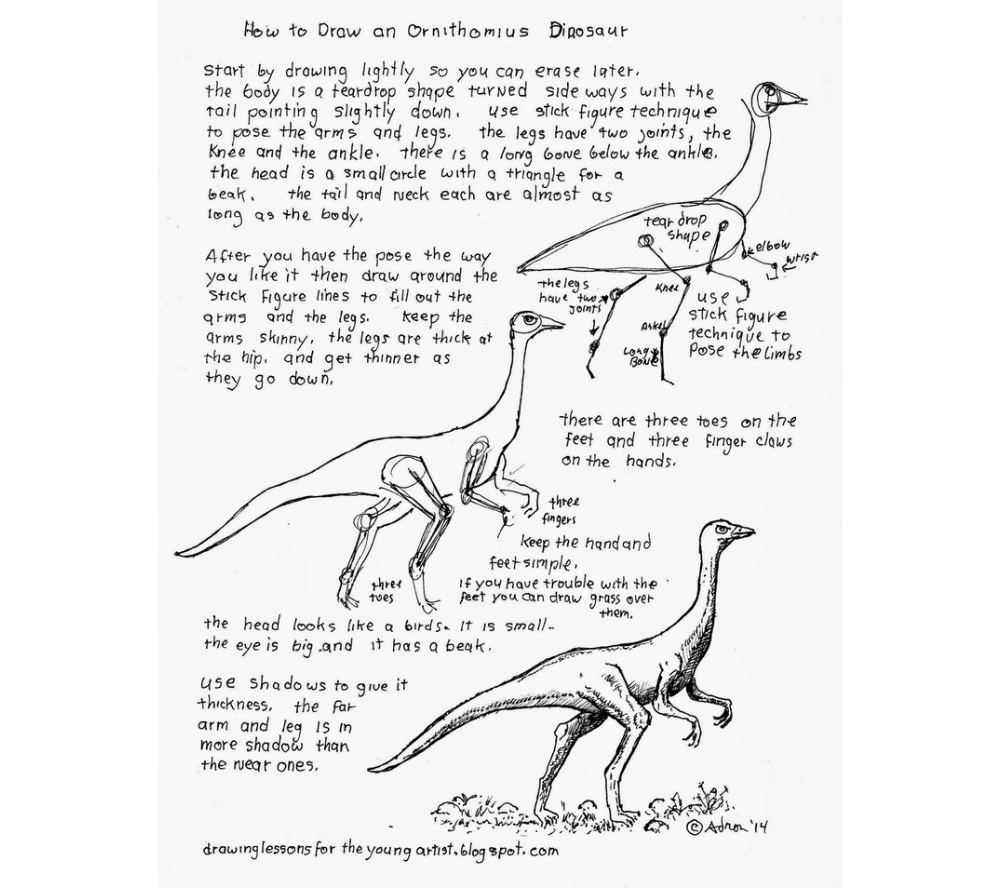How to Draw an Ornithomimus Dinosaur (Perfected Guide)
Materials: Pencil, eraser, paper, optional fine liner/shading tools.

1. Light Sketching & Basic Shapes
-
Body:
-
Draw a sideways teardrop shape (rounded at the chest, tapered toward the tail). Angle the tail slightly downward.
-
-
Head:
-
A small circle for the skull with a triangle attached for the beak (think bird-like).
-
-
Neck & Tail:
-
Both should be as long as the body. Use smooth, curved lines to connect the head to the body and extend the tail.
-
2. Stick Figure Posing
-
Legs:
-
Use two joints: Bend the knee forward and the ankle backward (like a bird’s leg).
-
Add a long metatarsal bone below the ankle (key for Ornithomimus’ posture).
-
-
Arms:
-
Sketch thin, slightly bent stick lines for arms (hands will have three claws).
-
3. Fleshing Out the Body
-
Legs:
-
Thick at the hips, tapering toward the ankles. Add muscle definition with gentle curves.
-
-
Arms:
-
Keep them skinny and delicate. Draw three slender fingers with small claws.
-
-
Feet:
-
Three toes—middle toe longest, others shorter. Simplify by overlapping toes or hiding partial views.
-
Tip: Add grass or pebbles to obscure feet if needed.
-
4. Head Details
-
Beak: Refine the triangle into a smooth, slightly curved beak (no teeth).
-
Eye: Large and round, placed midway along the head circle. Add a tiny highlight dot for life.
-
Feathers (Optional): Lightly suggest fluff along the neck or tail with wispy lines.
5. Shading & Depth
-
Light Source: Assume light from one side (e.g., top-left).
-
Near Side: Leave lighter; add minimal shading.
-
Far Side: Darken the arm, leg, and underside of the tail/neck to show depth.
-
-
Texture: Use short, parallel lines on legs for scaly skin; smoother strokes for the beak.
6. Final Touches
-
Refine Lines: Trace over the final sketch with a darker pencil or pen. Erase guidelines.
-
Background: Add sparse grass or a desert horizon to ground the dinosaur.
Scientific Note: Ornithomimus was feather-covered, so consider adding a fringe of feathers along the arms/tail for accuracy.
Pro Tip: Study ostrich legs for reference—their posture is similar!
This method keeps the original simplicity while elevating realism. Happy drawing! 🦖✏️
Credit: Inspired by drawing lessons for the young artist.blogspot.com.
